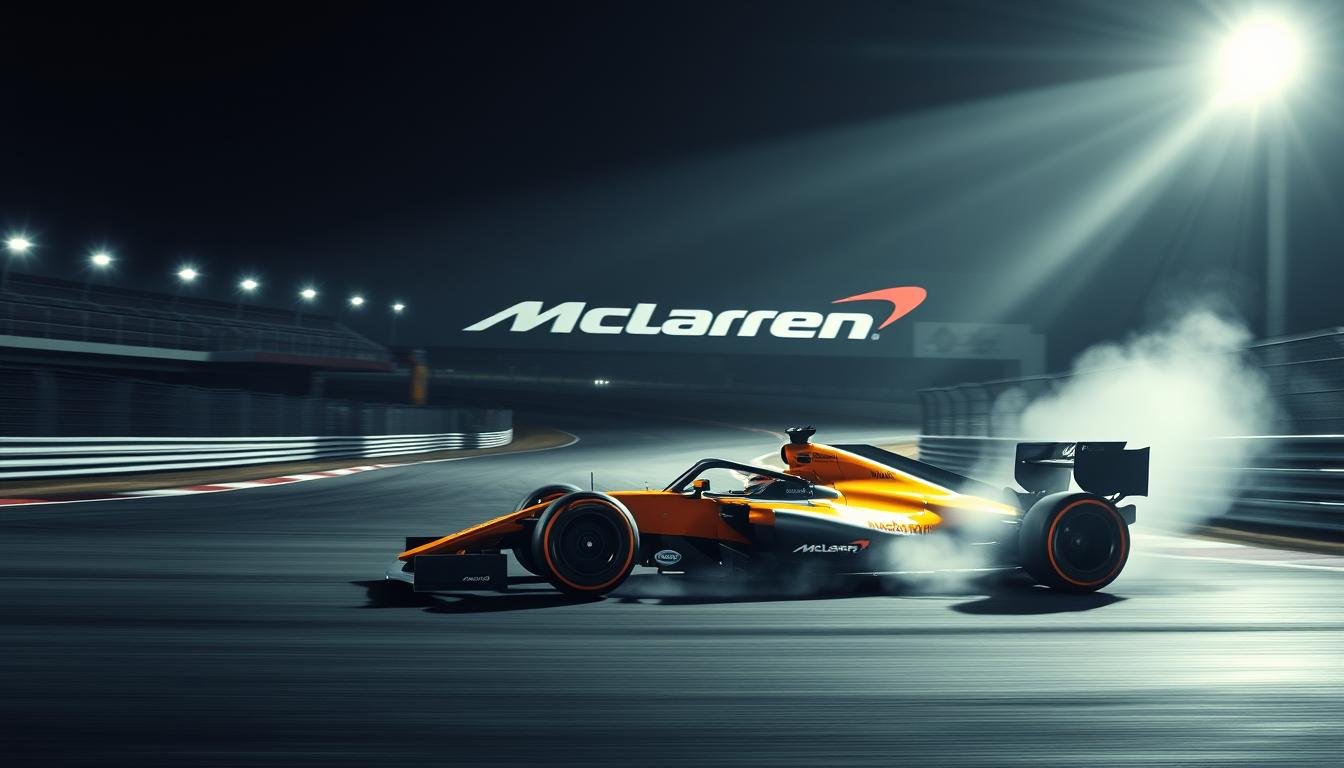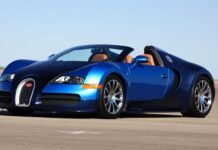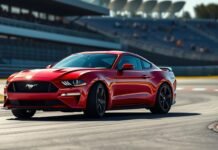From Speed to Glory: The Legendary Journey of McLaren Racing
Bruce McLaren, a young visionary, started the McLaren Racing legacy. At just 22, he won his first Grand Prix in 1959. This achievement set a record that lasted for 40 years. His passion for racing led to the creation of McLaren Racing, known for its success in Formula 1 and engineering.
McLaren has been a force in Formula 1 racing for over 50 years. They have won 182 Grand Prix races and eight Constructors’ Championships. Their 2024 victory ended a long period of challenges, echoing their success in the 1988 season. That year, Ayrton Senna and Alain Prost won 15 races with the MP4/4.
McLaren’s journey shows how motorsport has evolved. From dominating Can-Am races in the 1960s to introducing KERS systems in 2009, they have always pushed the limits. With over 1,579 race cars and 58 drivers, their legacy is built on strategy, talent, and innovation.
Key Takeaways
- McLaren holds 8 Formula 1 Constructors’ Championships and 182 Grand Prix victories.
- Bruce McLaren’s 1959 win at 22 set a record lasting 40 years.
- The 1988 MP4/4 won 15 of 16 races, cementing McLaren as a grand prix legend.
- In 2024, strategic adaptions like Monaco’s mid-season turnaround revived their title hopes.
- The team’s 58-year Formula 1 history includes 484 podiums finishes and 158 pole positions.
The Birth of a Racing Legacy: Bruce McLaren’s Vision
Bruce McLaren was a automotive visionary from New Zealand. He changed British motorsport forever. Born in Auckland, his love for speed started early. He overcame health issues to become a top Formula 1 engineer and driver.
From New Zealand to the World Stage
Bruce McLaren’s career took off in 1959 when he won the US Grand Prix at 22. He was the youngest driver to win at that time. He founded Bruce McLaren Motor Racing Ltd. in 1963, combining driving and engineering.
The team’s Colnbrook workshop was a place of innovation. They built cars like the M1 and M6A. These cars dominated the Can-Am series.
Founding McLaren Motor Racing in 1963
McLaren’s 1963 team was a blueprint for success. Key moments include:
- 1966: M1 sports car victory in the Can-Am series
- 1968: Historic Formula 1 debut with the M8A
- 1969: Unmatched performance with the M8B, winning all 11 Can-Am races
Early Racing Achievements
| Year | Vehicle | Achievement |
|---|---|---|
| 1963 | M1A | First race entry at the 12 Hours of Sebring |
| 1966 | M6A | First Can-Am championship win |
| 1968 | M8A | First Formula 1 race with a McLaren chassis |
Bruce McLaren’s legacy lives on through his motorsport history innovations. His work with carbon-fiber and the Papaya Orange livery is iconic. His death in 1970 showed the human side of a legend. Yet, his vision keeps driving McLaren’s racing pedigree today.
Tragedy and Triumph: Navigating the Post-Bruce McLaren Era
In 1970, the motorsport tragedy of Bruce McLaren’s death at 32 seemed to end McLaren’s legacy. But the team’s British racing heritage and racing team management showed great strength. Under Teddy Mayer, drivers like Denny Hulme and Peter Revson kept Bruce’s Formula 1 pioneers spirit alive.
By 1974, McLaren won its first McLaren championships. This was a racing history highlights moment, born from hard times. The team worked with visionary engineers like Gordon Murray. Murray introduced the carbon fiber chassis in 1981, starting a legacy of 182 F1 wins and 12 world titles by 2023.
| Year | Achievement |
|---|---|
| 1970 | Denny Hulme wins Can-Am title post-tragedy |
| 1974 | First Constructors’ Championship |
| 1981 | MP4/1: Carbon fiber chassis revolution |
| 1988 | 15 race wins with the MP4/4 “twin-turbo” |
| 2023 | Continued innovation in hybrid power units |
Ron Dennis led McLaren in the 1980s, making it a British racing heritage icon. His racing team management brought in Ayrton Senna and Alain Prost, winning 8 Constructors’ titles. Today, McLaren continues to innovate and push boundaries in Formula 1 innovation and determination.
The Ron Dennis Revolution: Transforming McLaren’s Fortunes
Under Ron Dennis, McLaren went from struggling to becoming a top Formula 1 team. His 1981 takeover brought a new racing philosophy of precision and big dreams. This move also brought back the British motorsport tradition and welcomed new ideas.
By 1988, McLaren’s MP4/4 was a sign of automotive excellence. It won 15 races and two championships, showing the team’s dominance.
The Acquisition That Changed Everything
In 1981, Dennis’s partnership with McLaren brought much-needed money and vision. He teamed up with Porsche for engines and hired John Barnard, a top engineer. The team’s new racing philosophy focused on the latest technology, like the carbon-fiber MP4/1 chassis in 1981.
Building a Racing Powerhouse
By 1988, McLaren had become a force with Honda’s help and drivers Ayrton Senna and Alain Prost. The team won 158 races under Dennis. The MP4/4 set a record with 15 wins in 1988, making McLaren a top contender.
Key achievements include:
- 10 Drivers’ Championships (Senna, Prost, Hamilton)
- 7 Constructors’ Championships
- Revolutionary carbon-fiber chassis
Management Philosophy and Team Culture
Dennis had a strict “no compromise” rule, aiming for automotive success in every aspect. His focus on top facilities, driver teamwork, and innovation made McLaren a model for Formula 1 teams. This approach kept the British motorsport tradition alive while pushing the limits.
| Achievement | Under Ron Dennis |
|---|---|
| Drivers’ Championships | 10 |
| Constructors’ Championships | 7 |
| Total Race Wins | 158 |
Golden Era: The Unforgettable Senna-Prost Rivalry
In the 1980s, McLaren became the top team in Formula 1 with Ayrton Senna and Alain Prost driving. Their rivalry, fueled by the MP4/4, changed the sport’s history. This time mixed technical skill with human drama, making McLaren a key part of Formula 1’s heritage.
The MP4/4: Formula 1’s Most Dominant Car
Gordon Murray designed the MP4/4, a game-changer in racing. With Honda’s V6 turbo engine, it won 15 out of 16 races in 1988. Its design and aerodynamics made it a legendary F1 car, showing McLaren’s engineering prowess. Honda’s 69 Formula 1 wins during this time highlighted the partnership’s success.
Championship Battles That Defined a Generation
Senna’s bold style met Prost’s strategic mind. In 1988, they won 15 races together, but their fights, like the 1989 Suzuka collision, are legendary. Senna won 8 races and got 104 points, while Prost won 7 and got 93 points, showing their fierce competition for the championship.
| Driver | 1988 Wins | Points |
|---|---|---|
| Ayrton Senna | 8 | 104 |
| Alain Prost | 7 | 93 |
Legacy of the McLaren Rivalry Years
Their rivalry changed how teams manage their drivers. Senna’s six Monaco wins, including the 1992 MP4/7 victory, and Prost’s strategic thinking set a new standard for rivalries. This era made Formula 1 drivers global icons, showing how engineering and passion together create Formula 1’s legacy.
McLaren Racing History: Decades of Formula 1 Dominance
McLaren entered Formula 1 in 1966 and quickly made a mark. They won their first grand prix victories in 1968 with Bruce McLaren. This win started a long list of motorsport achievements.
In the 1980s, under Ron Dennis, McLaren’s success grew. They won world champions like Niki Lauda and Alain Prost. The papaya orange color became a symbol of their speed and skill.
The 1990s brought Ayrton Senna and Mika Häkkinen, adding 10 Drivers’ titles. In 2008, Lewis Hamilton won the title, overcoming Ferrari. Despite challenges like the 2007 spying scandal, McLaren kept pushing forward.
They focused on young drivers like Lando Norris and Carlos Sainz Jr. This strategy led to a third-place finish in 2020.
McLaren has 182 grand prix victories and 8 Formula one championships. Their history is filled with technical genius and legendary drivers. In 2024, they won their first Constructors’ Championship in 26 years.
From Bruce McLaren’s early days to Hamilton’s historic wins, McLaren’s legacy inspires. Each F1 season highlights shows their status as motorsport royalty. Every racing milestone celebrates their dedication to excellence.
Engineering Excellence: Revolutionary Innovations from McLaren
McLaren has changed racing and car design with its endless innovation. They’ve used lightweight materials and data systems to lead in carbon-fiber technology and aerodynamic innovation. These advancements have shaped modern racing and more.
Pioneering Carbon Fiber in Formula 1
In 1981, John Barnard introduced the carbon-fiber monocoque for the MP4/1. This carbon-fiber technology made cars lighter and safer. John Watson’s survival in a 1981 Monza crash proved its worth. Now, this material is key in F1 and road cars like the McLaren Senna, showing engineering precision.
Aerodynamic Breakthroughs
McLaren’s aerodynamic innovation includes designs like ground-effect and F-ducts. These racing breakthroughs made the MP4/4 a champion. Today, active suspension and wing adjustments keep this legacy alive, balancing speed and grip.
Electronic Systems and Data-Driven Racing
McLaren was a leader in racing technology with early telemetry and engine systems. Now, with Dell Technologies, they analyze 6.5 billion data points daily. These technological breakthroughs also help in healthcare, improving stroke recovery with biometric data.
| Innovation | Description | Impact |
|---|---|---|
| Carbon Fiber Chassis | 1981 MP4/1 | Reduced weight by 30%, revolutionized automotive engineering |
| F-duct | 2010 airflow control system | Improved cornering speeds by 5% on circuits |
| Data Analytics | 6.5B data points analyzed daily | Optimizes performance in racing and healthcare applications |
The Monaco Masters: McLaren’s Special Relationship with the Iconic Circuit
McLaren has made a big mark at the Monaco Grand Prix. They’ve won 15 times, more than any other team. This success comes from their top-notch engineering and the skill of their drivers.
From Bruce McLaren’s first podium in 1968 to Lewis Hamilton’s 2022 win, they’ve shown their mastery. The tight streets of Monte Carlo are no match for them.
Ayrton Senna’s iconic race liveries are a symbol of motorsport passion. His five Monaco wins with McLaren (1984–1993) set the bar high.
“Monaco tests the soul of a driver,” Senna once said, “but McLaren’s cars always felt like an extension of my mind.”
This connection between car and driver is what defines theirFormula 1 culture.
In 2021, McLaren brought back Gulf’s historic livery, celebrating a 55-year partnership. The F1 circuits of Monaco are all about precision, fitting McLaren’s style perfectly. Their 15 wins, from Prost in 1984 to Norris in 2022, show their lasting impact.
Champions Behind the Wheel: McLaren’s Legendary Drivers
McLaren’s legacy shines through its legendary drivers. They turned engineering into racing wins. From Emerson Fittipaldi’s 1974 win to Lewis Hamilton’s 2008 breakthrough, they made history. Their stories highlight McLaren’s rise from a garage to grand prix fame.
Emerson Fittipaldi and James Hunt: The Early Champions
Emerson Fittipaldi won McLaren’s first driver championship in 1974. He combined precision with focus. James Hunt won in 1976, after a close battle with Niki Lauda. Their wins set the stage for future legends.
The Prost and Senna Era
Alain Prost and Ayrton Senna’s rivalry is Formula 1 lore. In 1988, McLaren’s MP4/4 won 15 races and all but one pole. They won four driver championships and five constructors’ titles, blending speed with strategy.
Mika Häkkinen, Lewis Hamilton, and Beyond
Mika Häkkinen won two driver championships in the ’90s. His determination was unmatched. Lewis Hamilton won in 2008 at 23, starting his legendary career. Now, McLaren looks for new champions to carry its legacy forward.
From Track to Street: The Birth of McLaren Automotive
In 1989, McLaren Automotive was born, building on McLaren’s sports car heritage. Ron Dennis led this new chapter, using racing automotive breakthroughs to create street-legal cars. The first car was the 1992 McLaren F1, a high-performance vehicle that set new speed records with its 240 mph top speed.
Gordon Murray’s vision brought hybrid technology to the road in 2013 with the McLaren P1. The 2019 Speedtail followed, combining 1,040 horsepower with hybrid systems. By 2024, CYVN Holdings took over, focusing on electric McLaren road cars.
| Model | Year | Units | Power | Notes |
|---|---|---|---|---|
| McLaren F1 | 1992-1998 | 106 | 627 BHP | First road car, $800k price tag |
| P1 | 2013 | 375 | 903 HP | Hybrid pioneer |
| Speedtail | 2019 | 106 | 1,040 HP | Most powerful McLaren road car |
| 750S | 2023 | N/A | 750 BHP | Last pure internal combustion model |
Every McLaren road car has racing roots. The 2024 CYVN acquisition pushes this legacy forward, making McLaren a leader in electric supercar history.
The McLaren F1: Redefining the Supercar
Gordon Murray wanted to make the ultimate road car when he created the McLaren F1. He mixed automotive innovation with performance excellence. The car was launched in 1992 and broke all the rules, combining Formula 1 tech with top-notch craftsmanship.
Its carbon fiber body was light, weighing just 1,138 kg. A big 6.1L V12 engine gave it 627 PS. It hit 240.1 mph (386 km/h), setting a record that lasted until 2005.
Gordon Murray’s Masterpiece
Murray’s design had no compromises. The driver sat in the middle, with two seats on either side. This made the car balanced and easy to see out of.
Inside, gold-lined engine bays and hand-finished carbon fiber showed off its luxury. Only 64 road cars were made, each costing $640,000. In 2021, one sold for $20.46 million, proving its value.
Racing Success Beyond Formula 1
In 1995, the GTR version won Le Mans, beating cars made just for racing. This showed the F1’s engineering skills. Out of 28 GTRs, three got podium spots, showing its racing ability.
Setting Standards for Generations
| Type | Units Produced |
|---|---|
| Road Cars | 64 |
| GTR (Racing) | 28 |
| 5 | |
| GT | 3 |
| Prototypes | 6 |
“The McLaren F1 wasn’t just a car—it was a statement of what automotive engineering could achieve.” — Gordon Murray
The F1’s impact is seen today. Its use of carbon fiber and mid-engine design set new standards. Even today, cars try to match its focus on the driver. With only 100 left, its rarity and performance excellence make it a legend in car history.
Modern Marvels: The P1, Senna, and Beyond
McLaren moved from racing to making road cars, changing the game. The MP4-12C, starting in 2011, used carbon fiber and twin-turbo V8s. This set the stage for the 650S and 720S, blending racing tech with daily use.
The McLaren P1 and Senna show the limits of what cars can do. The P1’s 903-horsepower hybrid system, combining a V8 with an electric motor, marked a new era. It reached 217 mph and went from 0-60 in under 3 seconds.
The Senna, made in just 500 units, packs 789 horsepower and hits 211 mph. Its design is inspired by F1 cars. Some, like chassis 496, have rare carbon inserts.
| Model | Engine | HP | 0-60 mph | Top Speed |
|---|---|---|---|---|
| McLaren P1 | 3.8L V8 + hybrid | 903 | 217 mph | |
| McLaren Senna | 4.0L V8 | 789 | 2.8 sec | 211 mph |
| McLaren Speedtail | 4.0L V8 hybrid | 1,035 | 2.3 sec | 250 mph |
| McLaren Artura | 3.0L V6 hybrid | 671 | 3.0 sec | 205 mph |
Now, McLaren offers the track-focused Speedtail and the grand touring GT. The Artura introduces a new V6 hybrid platform. The 720S remains a mid-engine legend. Each car shows McLaren’s commitment to excellence on both roads and tracks.
Challenging Times: Navigating the 21st Century Competitive Landscape
McLaren’s journey in the 2000s was filled with ups and downs. They faced engine failures and a tough period from 2015 to 2017. But, they came back strong in 2021 with Mercedes engines.
Recent wins, like Lando Norris’ victory in the 2024 Miami GP, show they’re back in the game. They’ve earned 666 Constructors’ Championship points, proving they’re contenders again.
partnership changes and engine supplier shifts>
Early 2000s were tough for McLaren due to engine issues. Honda’s V6 hybrid engines didn’t perform well from 2015 to 2017. This left them struggling at the back of the grid.
But, switching to Mercedes in 2021 brought stability. It helped them compete better and showed the value of reliable suppliers in motorsport.
| Team | 2023 Entry Fee | 2024 Entry Fee |
|---|---|---|
| McLaren | $6.4M (3-yr total) | $6.1M |
| Red Bull Racing | $7.4M | $4.6M |
| Sauber/Audi | – | $700K |
| Williams | – | $800K |
rebuilding for success>
Zak Brown’s leadership brought McLaren back to the top. James Key and drivers Norris/Piastri set a new path. Oscar Piastri is aiming for world titles, showing quick growth from F2.
Their 2024 season earned $140M in prize money. This shows how teams can evolve and succeed.
adapting to formula changing regulations>
The 2022 rule changes were a test for teams. McLaren’s 2024 title win shows they adapted well. Their car design in 2024 is a mix of performance and cost control.
“Team cohesion determines racing outcomes. McLaren’s modern era contrasts sharply with Ferrari’s historic unity.” – Autosport Analyst
McLaren’s journey in the 21st century shows even top teams face challenges. They’ve learned to balance partnerships, innovation, and rule changes. With Piastri aiming for 2025 success, their story is one of perseverance in motorsport.
McLaren’s Cultural Impact: Beyond the Racetrack
McLaren’s legacy goes beyond racing, shaping motorsport culture and showing British racing pride. Their cars, like the P1 and 720S, mix Formula 1 with British engineering. This appeals to sports car enthusiasts everywhere.
The P1’s hybrid engine shows how racing tech meets road cars. It shows McLaren’s drive for the best.
“McLaren’s engineering excellence has redefined automotive ambition,” states the brand’s heritage division. “Every vehicle embodies the spirit of pushing limits.”
McLaren’s influence is seen in movies, games, and fashion. They’ve worked with Richard Mille and Belstaff, making them global icons. Social media connects motorsport enthusiasts worldwide, sharing stories and tech.
The Young Driver Programme and STEM efforts help grow future innovators. This ensures McLaren’s legacy lives on.
For over 50 years, McLaren has led in British engineering. They’ve introduced carbon fiber and CFD aerodynamics. Their supercars, like the 720S, show constant improvement.
Today, McLaren stands as a cultural symbol. It shows the values of high-speed racing and innovation, reaching far beyond racing.
The Technology Centre: Inside McLaren’s Futuristic Headquarters
The McLaren Technology Centre (MTC) is a symbol of Formula 1 innovation and engineering precision. Sir Norman Foster designed this 500,000 m² campus in Woking, UK. It combines advanced architecture with practical design.
The site has an artificial lake that cools the building. It also reflects the building’s sleek curves.
Norman Foster’s Architectural Vision
The MTC’s circular shape and 5,000-ton steel frame reflect McLaren’s automotive evolution. Its design, with wide workspaces and walkways, encourages teamwork. Over 100,000 trees surround the complex, blending nature with racing developments.
- Opened in 2004 after a £300m investment
- Consolidated 18 former sites into one hub
- Features 300,000 m³ of excavated earth in its foundation
A Facility Built for Innovation
At the MTC’s core is a 145m-long wind tunnel weighing 400 tonnes. Its 4m fan spins at 600 rpm, mimicking race conditions for F1 engineering advancements. A 34,500 m² Production Centre (MPC) nearby assembles supercars, combining automotive technology with craftsmanship.
| Facility | Key Feature | Technical Detail |
|---|---|---|
| Wind Tunnel | Length | 145 meters |
| Production Centre | Annual Supercar Output | ~5,000 units |
| Complex | Total Employees | 3,500 |
The Working Environment Behind the Success
Ron Dennis’s “80% NASA, 20% Disney” vision shapes the MTC’s culture. Employees move via an underground walkway between MTC and MPC, fostering synergy between racing and road car teams. The open layout ensures ideas flow freely among engineers, designers, and technicians.
With 1,500 staff and 25 historic race cars displayed, the MTC embodies McLaren’s legacy. Its facilities, from simulators to carbon-fiber labs, turn engineering precision into reality, driving every automotive technology advancement.
Racing into Tomorrow: McLaren’s Vision for the Future
McLaren is setting new standards in the automotive world, looking ahead to the future. Lando Norris’s win in the 2024 Miami Grand Prix and Oscar Piastri’s 11 pole positions show their skill. With over 60 years of history, they’re now combining old traditions with new tech.
The 2026 Formula 1 rules will bring new challenges. McLaren plans to use hybrid tech and green practices to meet these. They’ve also invested $25 million in a new IndyCar facility in Indiana, showing their growth plans.
This new center, opening in 2024, will create 175 jobs. It’s a big step for McLaren in North America. Their work in healthcare and data shows they’re not just about racing.
McLaren Applied is making a mark in healthcare and data too. They want to win races and protect the planet. Their partnership with Mercedes is helping them achieve this.
Zak Brown, the CEO, says staying consistent is key to winning. McLaren is investing in young talent through programs like the 2025 Early Careers Pathway. They’re keeping their edge by mixing tradition with innovation.
Conclusion: The Enduring Spirit of McLaren Racing
McLaren Racing started in 1963 and won the 2024 Constructors’ Championship. This victory shows their long history of success in motorsports. They have won 8 Formula 1 championships and 183 races, making them legends in the sport.
The team’s journey is filled with moments of greatness. Ayrton Senna and Alain Prost are just a few names that have made a lasting impact. Their 2024 win was a big comeback, thanks to smart decisions and skill.
McLaren has always been about blending old and new. From Bruce McLaren’s dream to today’s stars like Lando Norris and Oscar Piastri, they keep pushing the limits. Their home, the McLaren Technology Centre, is a hub for innovation.
They have made history with 161 fastest laps and 494 podiums. Even with tough competition from Mercedes and Red Bull, McLaren keeps showing they’re a force to be reckoned with. Their use of hybrid technology and mental toughness programs has helped them stay on top.
McLaren’s bright orange color is a tribute to their founder, Bruce McLaren. Their 2024 win adds to their impressive list of achievements. Under CEO Zak Brown, they’re focused on growing their talent and legacy.
McLaren’s story is not just about the past. It’s a guide for their future success, both on and off the track.
FAQ
What inspired Bruce McLaren to start his racing team?
Bruce McLaren loved racing from a young age in Auckland, New Zealand. He overcame Perthes disease and started McLaren Motor Racing in 1963. This was his dream come true.
How did the loss of Bruce McLaren impact the team?
Bruce McLaren’s death in 1970 was a huge blow. But Teddy Mayer and others kept his dream alive. They worked hard and won their first Constructors’ Championship in 1974.
What was Ron Dennis’s contribution to McLaren?
Ron Dennis bought McLaren in 1981. He brought a new level of professionalism. His focus on engineering led to many championships in the 1980s.
What characterized the rivalry between Ayrton Senna and Alain Prost?
Senna and Prost’s rivalry was intense. They had different driving styles. Their battles were legendary, including the 1989 Suzuka collision.
How has McLaren influenced Formula 1 and automotive engineering?
McLaren introduced the carbon fiber monocoque with the MP4/1. They also led in aerodynamics and electronics. These innovations changed Formula 1 and high-performance cars.
What is McLaren’s record at the Monaco Grand Prix?
McLaren has the most Monaco Grand Prix wins. Ayrton Senna’s five victories helped solidify their legacy. They are a force to be reckoned with on this circuit.
Which drivers are considered McLaren’s most legendary champions?
McLaren’s greatest drivers include Emerson Fittipaldi, James Hunt, Ayrton Senna, Alain Prost, Mika Häkkinen, and Lewis Hamilton. Each brought their unique talent to the team.
What is the significance of the McLaren F1 supercar?
The McLaren F1 was a game-changer. Designed by Gordon Murray, it had a central driving position and used carbon fiber. It set new standards for supercars.
How does McLaren Automotive differentiate itself in the market?
McLaren Automotive focuses on lightweight cars, aerodynamics, and driving experience. They stand out from other supercar makers.
What are McLaren’s future aspirations in both racing and automotive divisions?
McLaren wants to win in Formula 1 again. They also plan to make hybrid and electric cars. They aim to stay at the forefront of performance and innovation.





